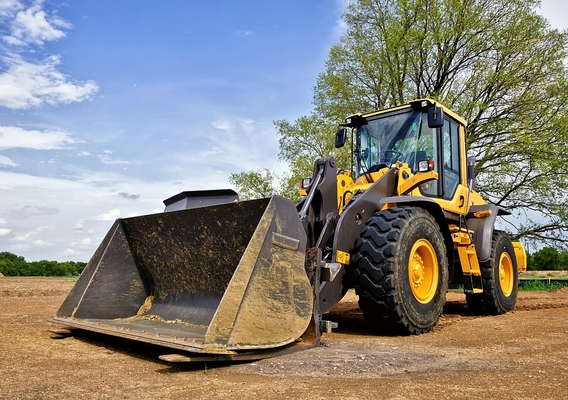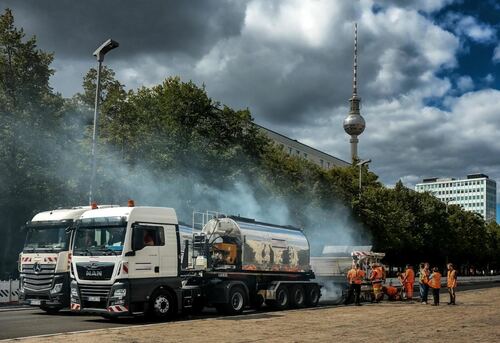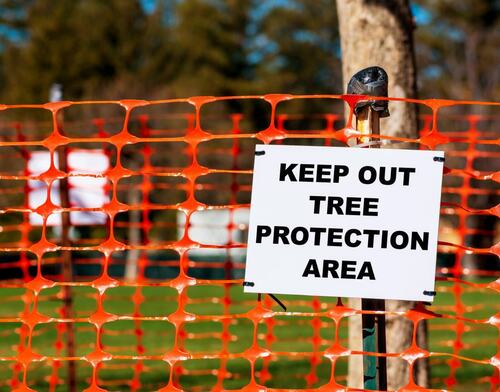Protecting Trees from Construction Chaos

Introduction
Urban trees must cope with a constant parade of assaults.
They live amid polluted air, grow in confined areas, and suffer scars. However, these damaging deeds pale in comparison to the primary threat facing urban trees: Construction projects.
The Nature of the Harm

Roadside Construction Can Harm Urban Trees - Photo by Wolfgang Weiser
Construction projects can harm trees in a variety of ways:
- The sheer number of workers laboring near trees during an extended construction project—every one of whom are sure to ding, knock, and nick a few trees—can cause trees to decline.
- Vehicles may bump into trunks, dislodging bark, wounding the underlying cambium, and predisposing the tree to decay.
- Changes in the amount of sun exposure can cause trees to struggle in the shade or suffer from sunscald.
- Trees often become more susceptible to windthrow after construction projects.
- Large branches may break as bulldozers and other heavy equipment plow through the area.
Nevertheless, the most problematic damage wrought by construction projects occurs at ground level. The heavy traffic that accompanies construction activities compacts the soil. Roots have a difficult time growing in compacted soil, and they cannot access enough air to survive. Compromised soil structure also retards the rate of water infiltration, which reduces the amount of water available to the trees.
Additionally, many trees have their root systems damaged or cut during construction activities. This often occurs during the digging of trenches for utility lines or pipes. Even if the soil does not become compacted, and the tree’s roots are not destroyed outright, grade changes are often problematic for trees.
The roots of different tree species have evolved to grow at specific depths. When the grade is raised, the roots often become stressed from a lack of air, and they eventually die. Conversely, those that become exposed by grade reductions are at increased risk of physical damage or fungal colonization.
Preventative Protection
Fortunately, protecting trees from construction damage is often a simple task, and it rarely raises the costs of construction significantly.
The first step is to avoid as many conflicts as possible through careful planning. In other words, place access points, storage sites, and other high -traffic areas in places where the heavy activity is unlikely to harm nearby trees. Often, it is wise to have an ISA-certified arborist assess the lot and prepare a tree inventory. This will allow the stakeholders to identify trees that require protection and design a plan to protect them. It is generally wise to remove any trees that are not healthy at this time.
Building Barriers

A Temporary Barrier Protects Trees from Construction Traffic
After identifying potential problems and trees that require protection, you can place barriers around the trees to keep people and vehicles from encroaching on these areas. Such areas are called “Tree Protection Zones," or TPZs. While TPZs should prevent mechanical damage to the tree’s trunk, branches, and canopy, the protection they provide the soil is of greater importance.
To determine the size of the necessary zone, arborists consider a variety of factors, but a rule of thumb suggests that the tree protection zone should have a radius of about 1.25 to 2.5 feet for every inch of trunk diameter, measured about 4.5 feet from the ground. In other words, a small pine tree with a three-inch-diameter trunk requires a TPZ with a radius of at least 3.75 feet, although a 7.5-foot radius would be even better.
Careful Excavation
When trenches are necessary, the root systems of nearby trees can be exposed with an air spade. This allows arborists and construction foremen to visualize the tree’s root system without damaging the delicate roots. It may be possible to cut a few minor roots to accommodate utility lines or pipes; when performed under the supervision of an ISA-certified arborist, such measures are unlikely to cause the tree extreme harm. At other times, removal may be required if no alternative route can be established for the trench.
Big and Small
Concern about tree protection is not limited to big developers and commercial contractors; even small projects can lead to lost trees. The installation of irrigation lines, pools, driveways, and sidewalks can necessitate grade changes or the digging of trenches. You could conceivably kill one of your trees while putting in a swing set or gazebo.
For that matter, construction projects are not the only activities that can traumatize trees. Heavy foot or vehicular traffic of any kind can compact the soil around the base of a tree, just as baseball-bat-swinging children can damage a tree’s trunk. Accordingly, you may want to employ protective principles to give your trees the best chance of remaining vibrant and healthy. While you probably do not want to put up plastic construction fencing around the picturesque oak in your backyard, carefully arranged planters, benches, or hedges may produce the same effect.
Calling in Reinforcements

San Francisco's Construction-Hardy Street Trees - Photo by Casey Horner on Unsplash
Now that you know about the damage construction projects can inflict on your trees, be sure to protect them to the best of your ability. If you need help establishing tree protection zones in the Bay Area, contact Arborist Now to enlist the help of a licensed, insured, ISA-Certified arborist who provides such services. Your trees will surely thank you.
Originally published on May 26, 2016.





